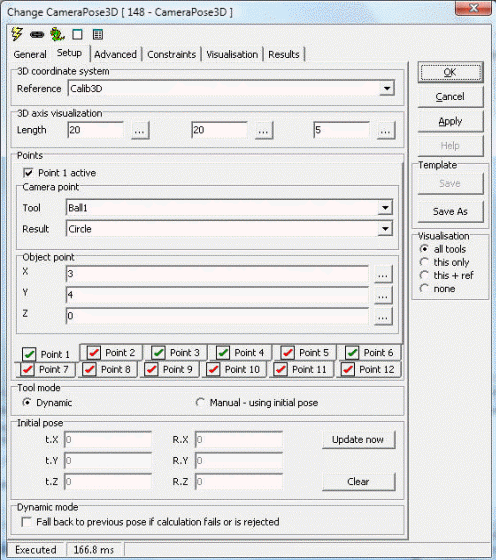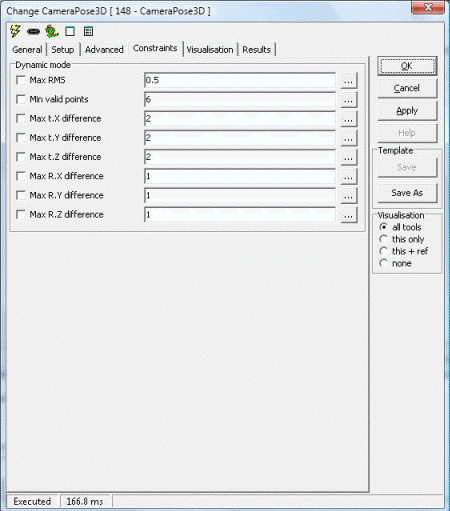Points - up to 12 points
These are 2D tool results connected to its corresponding 3D position.
- Active - toggle
calculation of this point
Camera point
- Tool - tool that reports
a point
- Result - which point
result to use
Object point
-
x,y,z coordinates given in the 3D coordinate system

Constraints
-
Max deviation for accepted
point - acceptance
criterion for each point (see Deviation above).
- Ignore camera points with deviation ratio over
[dB] - ignore cameras where 3D deviation
ratio to the best camera is over the threshold - measured in dB
-
Ignore camera points with deviation over - used to remove
"bad" points before estimating position in space
-
Minimum number of active cameras - accept point only if at least
this many cameras have a valid result
Constraints for mean point
This is active only if All points the same is checked on the Setup
page. All found points are averaged and results taken from there.
-
Max deviation (spread) for accepted
point - acceptance
criterion for the common (mean) point. The spread is calculated
in 2D as the maximum distance from the incoming tool points to the mean
point.
-
Minimum number of accepted points - accept mean point only if at least
this many points have a valid result.
Include in on-screen-description - requires description to be
active under Visualisation
- Point number - (not available if All points the same
is checked)
- 3D Coordinates
- Deviation/spread

Visualisation
|
AcceptedPoint |
Point that passes constraints |
|
FailDescription |
Description of a failed point |
|
FailedPoint |
Found point that fails constraints |
|
IncomingPoint |
Input points from other tools |
|
OKDescription |
Description of an accepted point |
Results
|
Point[1-8].x |
X position for found 3D point |
|
Point[1-8].y |
Y position for found 3D point |
|
Point[1-8].z |
Z position for found 3D point |
|
Deviation[1-8] |
Point deviation |
|
Cameras used[1-8] |
Number of used cameras for point |
|
Cameras in use[1-8] |
Python tuple of the cameras used to generate the result |
|
Accepted[1-8] |
Constraints result (0=fail, 1=accepted) |
|
Mean point (.x,.y,.z) |
Mean of found points (only for all points are the same) |
|
Spread |
Max distance from single point to the mean |
|
Active points |
Count of active input points |
|
Accepted points |
Count of points accepted and reported |
Example 1: Measure Distance Between Points
import math
def Distance3D (x1,y1,z1,x2,y2,z2):
return math.sqrt((x1-x2)*(x1-x2) + (y1-y2)*(y1-y2) + (z1-z2)*(z1-z2))
def GetPoint3D(name):
x = GetFloatValue(name+'_x')
y = GetFloatValue(name+'_y')
z = GetFloatValue(name+'_z')
return x,y,z
def SetPoint3D(name,x,y,z):
SetFloatValue(name+'_x',x)
SetFloatValue(name+'_y',y)
SetFloatValue(name+'_z',z)
x1,y1,z1 = GetPoint3D('Points3D1.Point1')
x2,y2,z2 = GetPoint3D('Points3D1.Point2')
x3,y3,z3 = GetPoint3D('Points3D1.Point3')
width = Distance3D(x1,y1,z1,x2,y2,z2)
height = Distance3D(x1,y1,z1,x3,y3,z3)
print 'w,h -',width,height